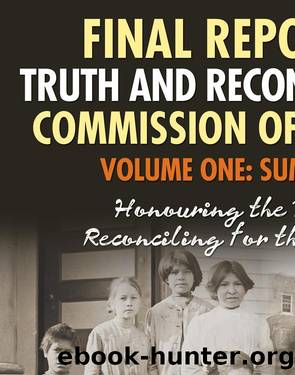Final Report of the Truth and Reconciliation Commission of Canada,Volume One: Summary by Truth and Reconcilation Commission of Canada

Author:Truth and Reconcilation Commission of Canada
Language: eng
Format: epub
Publisher: James Lorimer & Company Ltd., Publishers
Published: 2015-07-22T00:00:00+00:00
The Canadian Museum for Human Rights
As a national public history institution, the new Canadian Museum for Human Rights (CMHR) in Winnipeg is mandated to âexplore the subject of human rights, with special but not exclusive reference to Canada, in order to enhance the publicâs understanding of human rights, to promote respect for others, and to encourage reflection and dialogue.â143 Speaking at the TRCâs Forum on the National Research Centre in Vancouver on March 3, 2011, CMHR President and Chief Executive Officer Stuart Murray talked about the museumâs vision for, and role in, national reconciliation. He emphasized the prominent role of the CMHRâs First Nations, Inuit, and Métis advisors, as well as the Elders Advisory Council, Aboriginal Youth Council, and the broader Aboriginal community, in the planning and programs developed by the museum.144
Given the deep controversies that exist regarding the history of the residential school system, it is perhaps not surprising that the CMHR was criticized by the Southern Chiefs Organization in Manitoba in June of 2013, after media reports that the museum would not âlabel human rights violations against First Nations as genocide.â From the Southern Chiefs Organizationâs perspective, the museum was âsanitizing the true history of Canadaâs shameful treatment of First Nations.â145 Stuart Murray issued a statement on July 26, 2013, clarifying the museumâs position.
In the Museum, we will examine the gross and systemic human rights violation of Indigenous peoples. This will include information about the efforts of the Aboriginal community, and others, to gain recognition of these violations as genocideâand we will use that word. We will look at the ways this recognition can occur when people combat denial and work to break the silence surrounding such horrific abuses.... We have chosen, at present, not to use the word âgenocideâ in the title for one of the exhibits about this experience, but will be using the term in the exhibit itself when describing community efforts for this recognition. Historical fact and emerging information will be presented to help visitors reach their own conclusions. While a museum does not have the power to make declarations of genocide, we can certainly encourageâthrough ongoing partnership with the Indigenous community itselfâan honest examination of Canadaâs human rights history, in hopes that respect and reconciliation will prevail.146
The museum signalled its intention to create opportunities for Canadians to engage in a much broader and long-overdue public dialogue about the issue of genocide as it relates to the residential school system. The CMHR envisioned creating a public education venue for teaching all Canadians to think more critically about the history of human rights violations against Aboriginal peoples.
Speaking about the forthcoming 2017 commemoration of Canadaâs Confederation, Murray observed that Canadaâs human rights record is not unblemished, and that
for many Aboriginal communities, this is not necessarily an event that warrants celebration. But by looking honestly and openly at our past, by engaging a diversity of voices and perspectives, and by celebrating what has been accomplished to overcome these mistakes, we will serve to make our nation more united, more proud, and more just.
Download
This site does not store any files on its server. We only index and link to content provided by other sites. Please contact the content providers to delete copyright contents if any and email us, we'll remove relevant links or contents immediately.
| 19th Century | 20th Century |
| Exploration | First Nations |
| Founding | Pre-Confederation |
| Province & Local | War of 1812 |
Cat's cradle by Kurt Vonnegut(15190)
Pimp by Iceberg Slim(14399)
4 3 2 1: A Novel by Paul Auster(12290)
Underground: A Human History of the Worlds Beneath Our Feet by Will Hunt(12027)
The Radium Girls by Kate Moore(11930)
Wiseguy by Nicholas Pileggi(5675)
Perfect Rhythm by Jae(5326)
American History Stories, Volume III (Yesterday's Classics) by Pratt Mara L(5257)
The Fire Next Time by James Baldwin(5252)
Paper Towns by Green John(5092)
Pale Blue Dot by Carl Sagan(4917)
A Higher Loyalty: Truth, Lies, and Leadership by James Comey(4851)
The Mayflower and the Pilgrims' New World by Nathaniel Philbrick(4428)
The Doomsday Machine by Daniel Ellsberg(4420)
Killers of the Flower Moon: The Osage Murders and the Birth of the FBI by David Grann(4387)
The Sympathizer by Viet Thanh Nguyen(4307)
Too Much and Not the Mood by Durga Chew-Bose(4278)
The Borden Murders by Sarah Miller(4251)
Sticky Fingers by Joe Hagan(4106)
